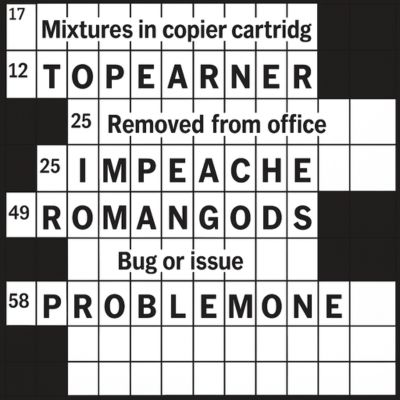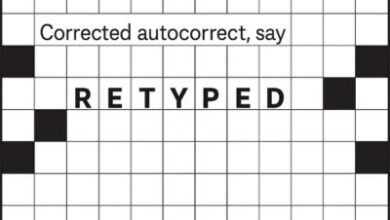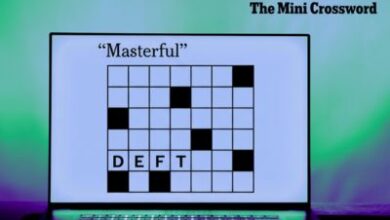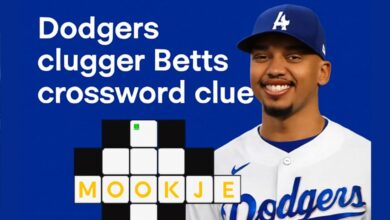Mixtures in Copier Cartridges NYT – Decoding the Fruitless Crossword Clue

Crossword enthusiasts across the world eagerly await each new puzzle from The New York Times. The NYT crossword has become not just a pastime, but a daily mental workout, loved for its clever wordplay, cultural references, and linguistic trickery. Every clue hides a story, a twist, or a pun waiting to be uncovered.
One such clue that drew attention appeared in the August 7, 2025, NYT crossword: “Mixtures in copier cartridges.” At first glance, this seems like an ordinary definition-based clue. Yet, hidden beneath its simple phrasing lies a delightful layer of wordplay — a hallmark of great crossword craftsmanship.
This article explores what the clue means, the answer behind it, the clever construction that made it special, and what lessons it offers both for crossword solvers and word lovers.
Understanding the Clue
The clue “Mixtures in copier cartridges” seems to suggest a straightforward answer — toners. After all, toner is the powdered mixture used in copiers and printers. For a daily or midweek puzzle, “TONERS” would have been the perfect, simple solution.
However, in this particular Thursday puzzle, the actual answer was TOPEARNERS — a ten-letter word that seems completely unrelated to photocopiers or mixtures. So, how does this make sense?
The secret lies in the puzzle’s theme. Thursday puzzles in The New York Times are famous for being “theme tricksters” — they bend the usual rules of word association. Constructors love using rebuses, letter swaps, missing parts, or hidden words to create that “aha!” moment for solvers.
This clue belongs to a themed puzzle where every major entry contained a hidden fruit. When the fruit was removed, the remaining letters formed a word that fit the clue’s literal definition.
In this case:
- The grid entry is TOPEARNERS.
- Hidden inside it is the fruit PEAR.
- Remove the fruit — TO PEAR NERS → TONERS.
- “TONERS” perfectly fits the definition “Mixtures in copier cartridges.”
Thus, TOPEARNERS is a cleverly disguised answer: the solver has to understand the theme (“fruit removal”) to get from TOPEARNERS to TONERS.
The Theme – A “Fruitless” Concept
To fully grasp why “TOPEARNERS” works, we must look at the puzzle’s entire theme.
The constructor designed the grid so that every long theme answer contained the name of a fruit. When the fruit was removed, the leftover letters spelled a completely new word or phrase matching the given clue.
Here are the main examples from that puzzle:
- TOPEARNERS → remove PEAR → TONERS → Mixtures in copier cartridges.
- IMPEACHED → remove PEACH → IMED → Given medication, briefly.
- ROMANGODS → remove MANGO → RODS → Fishing tools.
- PROBLEMONE → remove LEMON → PROBE → Investigative device.
- The reveal clue: FRUITLESSLY → In vain … or how to read the answers to the starred clues.
The reveal ties everything together. The puzzle literally asks solvers to interpret the theme answers “fruitlessly” — by removing a fruit. It’s a beautifully self-referential piece of crossword design.
This explains why “Mixtures in copier cartridges” leads to TOPEARNERS. Once you remove PEAR, you’re left with TONERS — the mixtures themselves.
Why the Wordplay Works So Well
There’s a reason this clue, and the puzzle overall, resonated with solvers. It’s not just wordplay — it’s elegant construction. Let’s break down why this clue works on multiple levels.
1. Misdirection and Surprise
At first, “Mixtures in copier cartridges” seems to have an obvious answer. Solvers immediately think of TONERS. But the grid calls for ten letters, not six. That contradiction sparks curiosity — and once the theme becomes clear, the realization is deeply satisfying.
The misdirection is gentle but effective. The clue doesn’t rely on trick wording; it hides its twist inside the larger puzzle’s structure.
2. Internal Logic
Every element of the theme is consistent. Each long answer hides a fruit that, when removed, yields a new word that perfectly fits its clue. This internal logic is crucial — without it, the puzzle would feel arbitrary.
3. Playful Language
The idea of making words “fruitless” is a linguistic pun in itself. It turns a common idiom (“fruitless” meaning “without result”) into a literal instruction for the solver: remove fruit names from words.
4. Visual and Structural Balance
“TOPEARNERS” looks symmetrical and natural in the grid. The constructor didn’t force awkward or invented words to make the theme fit — each theme entry feels organic. That’s a sign of careful design.
The Joy of the Thursday NYT Puzzle
Among crossword solvers, Thursday is considered “theme day.” Monday puzzles are straightforward; Friday and Saturday are harder but themeless. Thursday sits in the sweet spot: a theme day for wordplay lovers.
“Mixtures in copier cartridges” represents everything solvers love about Thursdays:
- A clever twist that’s fair once you see it.
- A theme that feels rewarding when cracked.
- Humor and intelligence balanced in equal measure.
It’s not about obscurity or difficulty — it’s about insight. When solvers realize that “fruitless” is the theme mechanism, every answer suddenly makes sense. The puzzle transforms from confusion to clarity in a single satisfying moment.
Behind the Construction
Crafting a puzzle like this requires skill. Here’s how a constructor typically approaches such a theme.
1. Finding the Core Idea
The constructor starts with a concept — in this case, “remove a fruit from a word.” They might test whether there are enough English words containing fruit names that can yield valid base words after removal.
For instance:
- TOPEARNERS → remove PEAR → TONERS
- IMPEACHED → remove PEACH → IMED
- ROMANGODS → remove MANGO → RODS
- PROBLEMONE → remove LEMON → PROBE
2. Balancing the Theme Entries
Each theme answer must:
- Contain a fruit cleanly embedded.
- Yield a real word when the fruit is removed.
- Fit symmetrical positions in the crossword grid.
- Allow clean crossings with non-theme fill words.
This balance is crucial for playability. A single awkward crossing can ruin a solver’s experience.
3. Creating the Reveal
A strong theme puzzle needs a reveal — a final answer that tells solvers what’s going on. “FRUITLESSLY” is perfect because it’s a real word that describes both the theme mechanic and the act of futility (in vain). It also fits the NYT style, which prizes wordplay that loops back to literal meanings.
4. Writing Smooth Clues
Once the grid is complete, the constructor (and editor) craft clues that flow naturally, without signaling the trick too early. “Mixtures in copier cartridges” is ideal — it’s ordinary enough to hide the gimmick, yet fits perfectly when the solver decodes the theme.
Lesson in Linguistic Play
“Mixtures in copier cartridges” is more than a crossword clue — it’s a microcosm of how English can be manipulated for delight.
Language is elastic. Words like TOPEARNERS can hide entire stories within them. The fact that a fruit (PEAR) can hide in plain sight within a completely unrelated term shows how rich the language is for hidden patterns.
Crossword constructors exploit this flexibility. They look for overlaps, hidden words, sound patterns, and multiple meanings — transforming ordinary vocabulary into playgrounds for wit.
For solvers, decoding these patterns feels like discovering hidden messages in everyday words. It’s intellectual archaeology: unearthing meaning that was always there but unseen.
How Solvers Can Decode Themed Clues
When facing clues like “Mixtures in copier cartridges” where something seems off, seasoned solvers rely on intuition and strategy. Here are some approaches that can help anyone:
- Notice answer length discrepancies. If the clue suggests a short answer but the grid demands more letters, something thematic is happening.
- Look for repetition across long answers. If multiple long entries seem strange, they’re probably part of a shared gimmick.
- Search for a reveal clue. Many themed puzzles contain a central clue explaining the pattern. Words like “literally,” “in a way,” or “figuratively” often hint at wordplay.
- Re-evaluate literal meanings. Once you spot one theme answer, recheck others — patterns usually apply uniformly.
- Be patient. Thursday puzzles reward persistence and flexibility more than obscure knowledge.
Understanding these techniques turns frustration into fun. Once the theme “clicks,” everything falls into place.
Cultural and Creative Value of Crosswords
Beyond the solving joy, this clue highlights why crosswords endure as cultural artifacts. They blend art, logic, and language in a compact format.
1. Wordplay as Art
Clues like this show that creativity can thrive even within constraints. A constructor has only a limited grid, letter intersections, and symmetry requirements — yet manages to create layers of humor and surprise.
2. Mental Fitness
Crosswords exercise cognitive flexibility. A clue like “Mixtures in copier cartridges” forces solvers to juggle literal and lateral thinking, connecting real-world knowledge with abstract reasoning.
3. Shared Experience
When such clues go viral, blogs and crossword communities light up with discussions. People share their “aha!” moments and marvel at the constructor’s ingenuity. It becomes a shared celebration of language.
4. Appreciation of Craft
The more you analyze such clues, the more respect you develop for constructors and editors. Every letter placement, every misdirection, every reveal word is deliberate. It’s an art form that rewards both creator and solver.
The Broader Theme: Playing with Language
This crossword clue teaches a broader lesson about language itself — that meaning is layered, and words often hide unexpected patterns.
Consider how many fruit names hide inside common words:
- PEAR → TOPEARNERS
- PEACH → IMPEACHED
- MANGO → ROMANGODS
- LEMON → PROBLEMONE
Each fruit carries associations — sweetness, growth, natural imagery — and inserting them into unrelated words creates surprising combinations. Removing them then becomes a metaphor: making the words “fruitless” to reveal their true meaning.
This mirrors how language evolves — layers of meaning accumulate or fall away, revealing new senses over time. Crosswords compress that linguistic evolution into a single puzzle grid.
Why This Clue Resonated
Even among thousands of crossword clues, “Mixtures in copier cartridges” stands out because it’s deceptively ordinary yet profoundly clever. Solvers could recall it easily because it represented the moment they cracked the puzzle’s code.
It also embodies the ideal NYT Thursday clue — fair, thematic, and delightful once understood. It doesn’t rely on obscure trivia or gimmicks. Instead, it rewards recognition and reasoning.
In a world saturated with information, the appeal of such wordplay is timeless. It reminds us that intelligence can be joyful, and that even a phrase about copier toner can contain a hidden pear.
Takeaways for Writers and Puzzle Creators
Writers and puzzle constructors alike can learn from this clue.
- Clarity and deception can coexist. The best puzzles hide complexity in simplicity. The clue reads plainly yet operates on multiple levels.
- Themes should be discoverable, not impossible. “Fruitless” provides a fair hint once the solver sees one pattern.
- Language should surprise. Using common nouns (like fruits) in unusual contexts sparks engagement.
- Balance is key. The theme, grid design, and clues all harmonize without feeling forced.
- Reward the reader. Whether it’s a crossword solver or a blog visitor, delivering a satisfying reveal creates lasting impact.
Educational Value
For teachers or linguists, this puzzle can even serve as a classroom tool. It demonstrates:
- Morphological awareness — how smaller units (fruits) can exist inside larger words.
- Semantics — how meaning changes when parts of a word are added or removed.
- Linguistic play — how structure and function combine to create humor and surprise.
Such puzzles make language learning more engaging. They also foster appreciation for etymology and word structure among students.
Why the NYT Crosswords Endure
The New York Times crossword remains the gold standard because it respects its audience. It expects intelligence but not perfection, humor but not silliness, creativity but not chaos.
Clues like “Mixtures in copier cartridges” showcase that balance perfectly. They entertain without alienating, educate without preaching, and challenge without frustrating.
Every day, millions solve these puzzles not just for the answers, but for the shared ritual — that moment of recognition when letters align and wit triumphs.
The Beauty of Wordplay
At its core, wordplay is the purest form of linguistic creativity. It transforms the familiar into something surprising. The clue we’ve explored demonstrates how even mundane vocabulary — copier cartridges and toner — can become the foundation for joy.
Wordplay connects logic with imagination. It’s where language stops being utilitarian and becomes artistic. Crossword constructors and solvers alike share in that artistry, building meaning from misdirection, humor, and clever design.
Conclusion – A Final Word from Newsta
In the end, “Mixtures in copier cartridges” is more than a clue — it’s a celebration of how words hide and reveal meaning. The answer TOPEARNERS shows how something as simple as a fruit can transform language, turning ordinary words into delightful puzzles.
It reminds us that great writing, like great crosswords, rewards curiosity. Behind every clue lies a world of insight, waiting for discovery.
If you enjoyed this exploration of wordplay and puzzle design, you’re reading it on Newsta, where we celebrate the craft of language, puzzles, and creativity every week. Keep solving, keep learning, and keep playing with words — because language, like the best puzzles, is endless fun.



